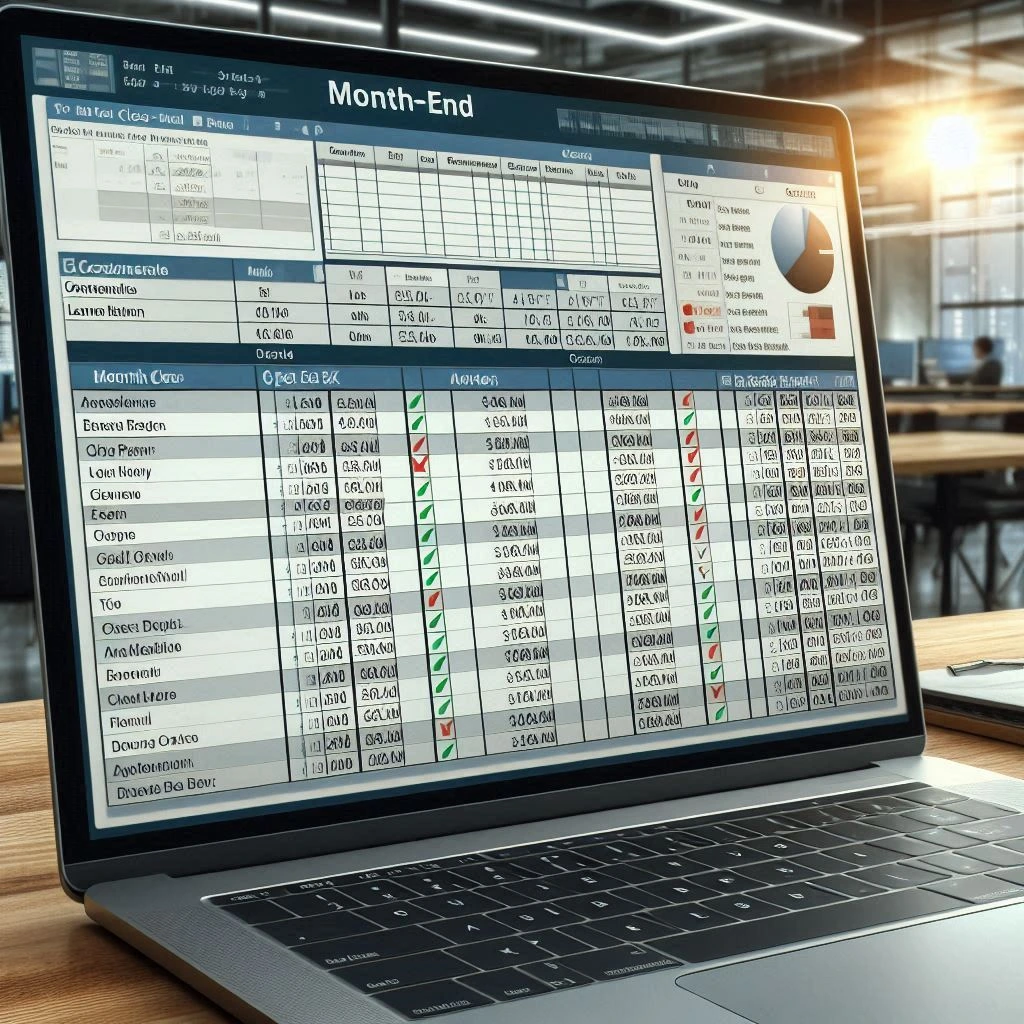The month-end close process is a critical component of accounting that ensures financial accuracy and compliance. It involves a series of tasks that accountants and auditors must complete to finalize the financial records for a given month. This process typically includes recording incoming cash, checking accounts receivable (AR) records, reconciling all accounts, and ensuring that all business transactions are accurately tracked. A well-structured month-end close checklist is essential for streamlining these tasks, reducing the risk of errors, and enhancing the overall efficiency of the closing process. To further assist with this, an accounting month-end close checklist Excel template can be extremely helpful [2][10].
Having a comprehensive checklist not only fosters standardized workflows but also provides a roadmap for the accounting team to ensure that all necessary tasks are completed in a timely manner. This is particularly important in maintaining the integrity of financial statements and supporting strategic decision-making within the organization [3][7].
However, it is crucial to recognize that different industries have unique needs and challenges that can impact their month-end close processes. For instance, a manufacturing company may require additional steps related to inventory valuation, while a service-based business might focus more on revenue recognition and client billing. Customizing the month-end close checklist to address these sector-specific requirements can significantly enhance its effectiveness, ensuring that all relevant tasks are included and prioritized appropriately [4][10].
By tailoring the Excel month-end close checklist to fit the specific demands of various industries, accountants and auditors can better manage their workflows, improve accuracy, and ultimately contribute to the financial health of their organizations. This customization not only aids in compliance but also supports the strategic objectives of the business, making it a vital practice for industry-specific financial professionals [6].
Understanding the Month-End Close Process
The month-end close is a crucial accounting procedure that involves finalizing all financial activities for a given month. This process ensures that financial records are accurate, complete, and ready for reporting. Here’s a deeper look into the month-end close process, its objectives, and the challenges that accountants and auditors often encounter.
Definition of Month-End Close
The month-end close refers to the systematic review, documentation, and reconciliation of all financial transactions that occurred during the previous month. This process is essential for maintaining the integrity of financial records and involves collecting and reconciling data from various sources, including bank statements, invoices, and expense reports [3].
Key Objectives
The primary objectives of the month-end close process include:
- Accuracy: Ensuring that all financial transactions are recorded correctly is vital. This involves verifying that all entries are complete and that there are no discrepancies in the financial data [12].
- Compliance: Adhering to accounting standards and regulations is crucial. The month-end close helps organizations ensure that their financial reporting meets legal and regulatory requirements [2].
- Timely Reporting: The month-end close process aims to produce financial reports promptly, allowing stakeholders to make informed decisions based on the most current financial data [3].
Common Challenges Faced During the Month-End Close
Despite its importance, the month-end close process can be fraught with challenges, including:
- Time Constraints: Accountants often face tight deadlines to complete the month-end close, which can lead to rushed work and potential errors [12].
- Data Discrepancies: Reconciling various financial records can reveal inconsistencies that need to be addressed, which can complicate the closing process [3].
- Resource Limitations: Many accounting teams may lack sufficient personnel or tools to efficiently manage the month-end close, leading to bottlenecks and delays.
- Sector-Specific Needs: Different industries may have unique requirements and complexities in their financial processes, making it essential for accountants to customize their month-end close checklists accordingly [2][10].
By understanding the month-end close process, its objectives, and the challenges involved, industry-specific accountants and auditors can better prepare and customize their Excel templates to meet the unique needs of their sectors. This foundational knowledge is crucial for enhancing the efficiency and effectiveness of the month-end close process.
The Role of Excel in Month-End Closures
In the realm of accounting, particularly during the month-end close process, the use of Excel templates has become increasingly prevalent. This is especially true for industry-specific accountants and auditors who require tailored solutions to meet their unique needs. Here are some key advantages of utilizing Excel for month-end close checklists:
- Flexibility and Customization Options: Excel offers unparalleled flexibility, allowing users to create customized month-end close checklists that cater to the specific requirements of different industries. Accountants can easily modify templates to include industry-relevant tasks, such as regulatory compliance checks for healthcare or inventory reconciliations for retail. This adaptability ensures that the checklist remains relevant and effective, accommodating the diverse operational nuances across sectors [3][10].
- Ease of Collaboration and Sharing Among Teams: Excel’s widespread use and familiarity among finance teams facilitate seamless collaboration. Multiple users can work on the same document, making it easy to share updates and track progress in real-time. This collaborative environment is crucial during the month-end close, where timely communication and coordination among team members can significantly enhance efficiency and reduce the risk of errors [4][6].
- Built-in Features that Enhance Data Accuracy and Reporting: Excel comes equipped with various built-in features that can improve data accuracy and streamline reporting processes. Functions such as data validation, conditional formatting, and pivot tables allow accountants to analyze financial data effectively and generate insightful reports. These features not only help in maintaining accuracy during reconciliations but also support the creation of comprehensive financial statements that are essential for audits and strategic decision-making [5][12].
Leveraging Excel for month-end close checklists provides industry-specific accountants and auditors with a powerful tool that enhances flexibility, promotes collaboration, and improves data accuracy. By customizing these templates to fit their sector’s needs, finance teams can ensure a more efficient and effective month-end close process.
Sector-Specific Needs: Customizing Your Excel Template
When it comes to the month-end close process, a one-size-fits-all approach may not be effective. Different industries have unique requirements that necessitate tailored checklists to ensure accuracy and compliance. Below are key considerations for customizing your Excel month-end close checklist for various sectors:
Manufacturing
- Inventory Accounting and Adjustments: Manufacturing firms must closely monitor inventory levels, including raw materials, work-in-progress, and finished goods. Adjustments may be necessary to reflect accurate inventory valuations.
- Cost of Goods Sold Calculations: Accurate calculation of the cost of goods sold (COGS) is crucial for understanding profitability. This involves tracking direct costs associated with production.
- Production-Related Accruals: Manufacturers often need to account for production-related expenses that may not be immediately recognized, such as utilities and labor costs incurred during the production cycle.
Retail
- Sales Reconciliation and Returns Processing: Retailers must reconcile sales data with cash receipts and account for returns, which can significantly impact revenue figures.
- Inventory Valuation Methods: Different methods (FIFO, LIFO, or weighted average) can affect the financial statements. The checklist should include steps to ensure the chosen method is applied consistently.
- Sales Tax Considerations: Retail businesses must ensure compliance with sales tax regulations, which can vary by jurisdiction. This includes calculating and remitting sales tax accurately.
Healthcare
- Revenue Recognition for Services Provided: Healthcare organizations face unique challenges in recognizing revenue, particularly with services rendered and third-party reimbursements.
- Compliance with Healthcare Regulations: The checklist should include steps to ensure adherence to regulations such as HIPAA and Medicare guidelines, which can affect financial reporting.
- Accruals for Salaries and Benefits: Healthcare providers often have complex payroll structures, necessitating careful accruals for salaries, benefits, and other employee-related expenses.
Non-Profit
- Grant-Based Accounting and Reporting: Non-profits must track funds received from grants and ensure they are used in accordance with donor restrictions. This requires specific entries in the month-end close checklist.
- Fund Accounting and Donor Restrictions: Non-profits often use fund accounting to segregate resources for specific purposes. The checklist should ensure that funds are allocated and reported correctly.
- Budget vs. Actual Analysis: Non-profits need to compare actual expenditures against budgeted amounts to assess financial health and make informed decisions about future funding and resource allocation.
By customizing your Excel month-end close checklist to address these sector-specific needs, accountants and auditors can enhance the accuracy and efficiency of their financial reporting processes. This tailored approach not only ensures compliance with industry regulations but also provides valuable insights into the financial health of the organization.
Key Components of a Customized Month-End Close Checklist
When creating a month-end close checklist tailored to specific industries, it is essential to consider the unique requirements and challenges faced by accountants and auditors in those sectors. A well-structured checklist not only streamlines the closing process but also ensures compliance and accuracy in financial reporting. Here are the key components to include in a sector-specific month-end close checklist:
1. Preparation Steps: Documentation and Data Gathering
- Identify Relevant Documentation: Each industry may have specific documents that are critical for the month-end close. For instance, manufacturing firms might need inventory reports, while service-based industries may focus on contracts and service agreements.
- Data Collection: Gather all necessary financial data, including transaction records, invoices, and receipts. This step is crucial for ensuring that all financial activities are accounted for during the month.
- Set Up a Timeline: Establish a timeline for data collection to ensure that all information is gathered promptly, allowing for a smooth transition into the review phase.
2. Review Procedures: Reconciliations, Adjustments, and Approvals
- Account Reconciliation: Conduct thorough reconciliations of all accounts, including cash, accounts receivable, and accounts payable. This process helps identify discrepancies and ensures that all financial records align with bank statements and other external documents.
- Adjustments: Make necessary adjustments based on the reconciliations. This may include correcting errors, recording accruals, or deferring revenues and expenses as per industry standards.
- Approval Processes: Implement a structured approval process for all adjustments and reconciliations. This step is vital for maintaining accountability and ensuring that all changes are reviewed by appropriate personnel.
3. Finalization Steps: Reporting and Distribution of Financial Statements
- Prepare Financial Statements: Generate key financial statements, including the balance sheet, income statement, and cash flow statement. Each industry may have specific reporting requirements, so it is essential to tailor these documents accordingly.
- Review and Analysis: Conduct a final review of the financial statements to ensure accuracy and compliance with relevant accounting standards (e.g., GAAP or IFRS). This analysis can provide valuable insights into the financial health of the organization.
- Distribution: Distribute the finalized financial statements to stakeholders, including management, investors, and regulatory bodies. Ensure that the distribution process is efficient and that all parties receive the necessary information in a timely manner.
By incorporating these key components into a customized month-end close checklist, accountants and auditors can address the specific needs of their industry, leading to a more efficient and accurate closing process. This tailored approach not only enhances financial reporting but also supports strategic decision-making within the organization.
Best Practices for Effective Month-End Closing
When it comes to the month-end close process, having a well-structured Excel checklist can significantly enhance efficiency and accuracy. Customizing this checklist to meet the specific needs of different industries is crucial for accountants and auditors. Here are some best practices to consider:
- Establishing Timelines and Deadlines: Setting clear timelines for each step of the month-end close process is essential. This includes deadlines for data collection, reconciliations, and final reporting. By establishing a timeline, teams can ensure that all tasks are completed in a timely manner, reducing the risk of errors and omissions. A well-defined schedule also helps in managing workloads and expectations among team members, ensuring that everyone is aligned on priorities and deliverables [10].
- Regular Reviews and Updates of the Checklist: The month-end close checklist should not be static; it requires regular reviews and updates to remain relevant. As industry standards and regulations evolve, so too should the checklist. Incorporating feedback from team members and analyzing past closing cycles can help identify areas for improvement. This iterative process ensures that the checklist remains a valuable tool that reflects current best practices and addresses any sector-specific requirements [3][13].
- Training and Communication Among Team Members: Effective communication and training are vital for a successful month-end close. All team members should be familiar with the checklist and understand their roles within the process. Regular training sessions can help reinforce best practices and ensure that everyone is equipped with the necessary skills to execute their tasks efficiently. Additionally, fostering an environment of open communication allows team members to share insights and address challenges collaboratively, ultimately leading to a smoother closing process [11].
By implementing these best practices, industry-specific accountants and auditors can customize their Excel month-end close checklist to better meet the unique demands of their sectors, enhancing the overall efficiency and accuracy of the financial closing process.
Conclusion
In the realm of accounting, particularly during the month-end close process, the significance of a customized checklist cannot be overstated. Tailoring your month-end close checklist to meet the specific needs of your industry offers several advantages:
- Enhanced Accuracy: A customized checklist ensures that all relevant tasks are included, reducing the risk of oversight and errors. This is particularly crucial in sectors with unique regulatory requirements or financial reporting standards, where missing a step can lead to compliance issues.
- Increased Efficiency: By focusing on industry-specific tasks, accountants and auditors can streamline their workflows, making the month-end close process quicker and more efficient. This allows teams to allocate their time and resources more effectively, ultimately leading to improved productivity.
- Better Insights: A tailored approach provides more relevant data and insights that can inform strategic decisions. Industry-specific metrics can be tracked more effectively, allowing for a clearer understanding of financial health and performance.
To harness these benefits, we encourage you to download and customize the Excel month-end close checklist template provided. This template serves as a foundational tool that can be adapted to fit the unique requirements of your industry, ensuring that your month-end close process is both thorough and efficient.
Moreover, we invite you to share your experiences and best practices with your peers in the industry. Engaging in discussions about what works and what doesn’t, can foster a community of learning and improvement, ultimately enhancing the month-end close processes across various sectors. Your feedback is invaluable, and together, we can refine our approaches to achieve greater accuracy and efficiency in our accounting practices.
Find out more about Shaun Stoltz https://www.shaunstoltz.com/about/
This post was written by an AI and reviewed/edited by a human.



